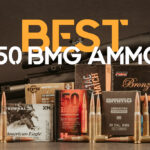
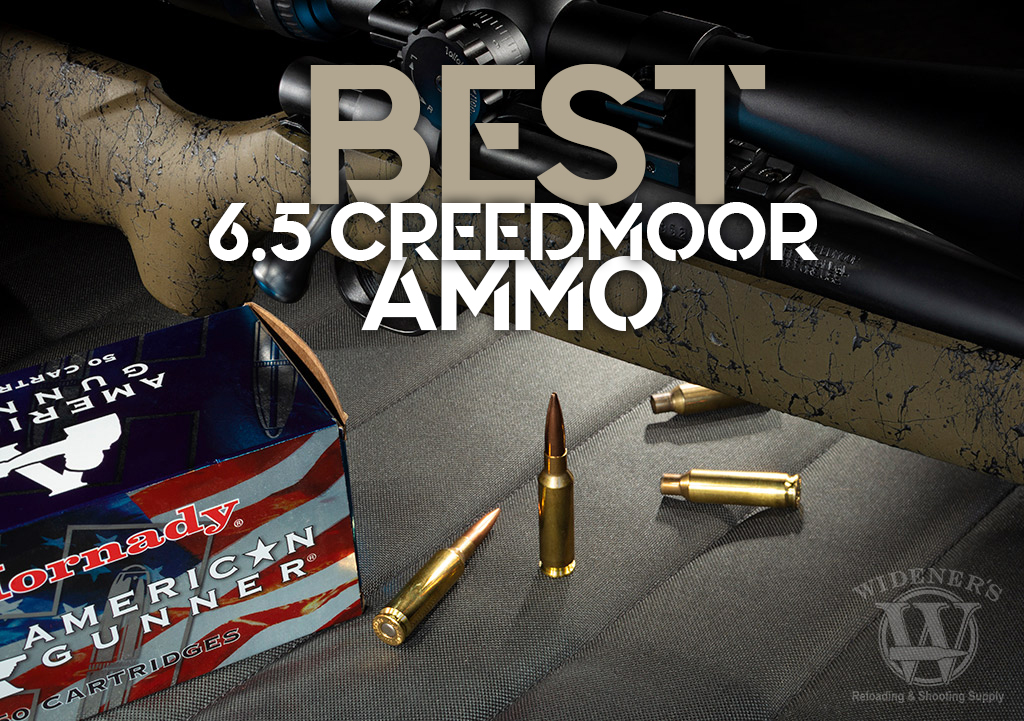
By Guy J. Sagi
The 6.5 Creedmoor has earned high praise across a wide spectrum of shooting disciplines, and for good reason. Hunters, competitive shooters, and long-range plinkers concur that the cartridge delivers downrange reliably without sacrificing shooter comfort. I’ll explore the best 6.5 Creedmoor ammo for your needs and discuss factors to consider when purchasing.
U.S. Special Operations Command verified those civilian claims in late 2017, when it tested 6.5 Creedmoor performance against two other cartridges. It found the hit probability doubled at 1,000 meters when compared to 7.62 NATO. Wind drift dropped by a third, and there was less recoil. In a head-to-head competition with .260 Rem., military experts found the pair nearly identical downrange, but concluded case design and bullet options give the edge to the Creedmoor.
Best 6.5 Creedmoor Ammo
Now, more than ever, there’s no good excuse for limiting your 6.5 Creedmoor fun to one or two loads. Every rifle is a little different, and the odds are good if you haven’t experimented with a different cartridge, you’re not witnessing the gun’s full accuracy potential.
The manufacturers, as always, have done the bulk of that homework by designing loads tailored for specific tasks. Here are some of our favorites.
Best 6.5 Creedmoor Ammo: Hunting
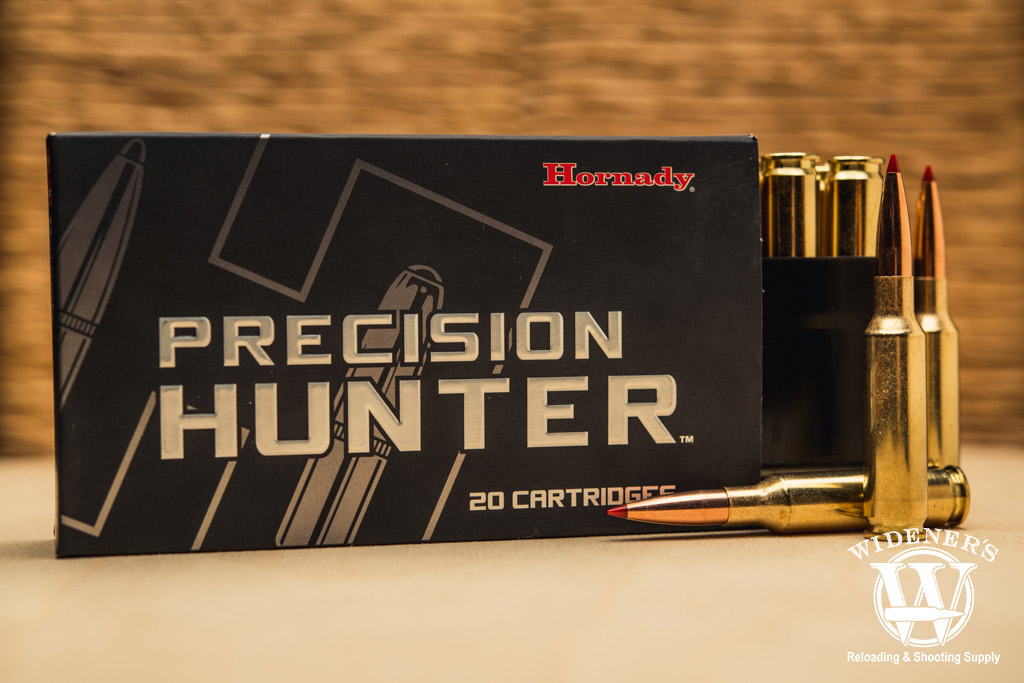
Bring home the big game with Hornady’s 143gr ELD-X Precision Hunter ammo.
Hunting requires the bullet to do double duty, and that’s no easy chore. Not only must it fly true, but impact velocity needs to be inside the speed window that forces proper bullet expansion (terminal performance). The 6.5 Creedmoor doesn’t bleed energy downrange at the rate of many other big-game cartridges and that makes projectile choice critical.
Hornady 143-grain ELD-X Precision Hunter
Hornady originally developed 6.5 Creedmoor for precision shooting competition, but quickly recognized the performance is ideal for big game. This 143-grain bullet offers a dynamic solution to a rather complex impact speed formula. Its thick shank and high InterLock ring provide 50 to 60 percent weight retention when hitting at anywhere from point-blank to 400 yards. When distances stretch further, its polymer Heat Shield drives back and into the projectile to promote expansion, retaining 85 to 90 percent of weight. Muzzle velocity is 2,700 fps and energy there is 2,315 ft-lbs. At 100 yards the figures drop to 2,557 and 2,076, respectively. If you’re wondering, at 500 yards the figures are 2,030 and 1,308.
| Caliber | Bullet Type | Bullet Weight | Velocity (Muzzle) | Energy (Muzzle) | 100 Yards (Velocity/Energy) | 200 Yards (Velocity/Energy) | 300 Yards (Velocity/Energy) |
|---|---|---|---|---|---|---|---|
| 6.5 Creedmoor | Poly | 143gr | 2,700 FPS | 2,315 FT LBS | 2,556 FPS/2,075 FT LBS | 2,417 FPS/1,855 FT LBS | 2,282 FPS/1,654 FT LBS |
Federal Non-Typical 140-grain Soft Point (SP)
Federal addresses terminal performance in a historically eloquent manner, with a modern touch. The soft-point design has a decades-old track record of clean kills, but this 140-grain soft point has a concentric jacket to ensure tag-punching performance across practical hunting distances with reliability. Muzzle velocity is 2,750 fps, where it generates 2,351 ft-lbs. of energy. Corresponding numbers are 2,546 fps and 2,014 ft-lbs. at 100 yards.
| Caliber | Bullet Type | Bullet Weight | Velocity (Muzzle) | Energy (Muzzle) | 100 Yards (Velocity/Energy) | 200 Yards (Velocity/Energy) | 300 Yards (Velocity/Energy) |
|---|---|---|---|---|---|---|---|
| 6.5 Creedmoor | SP | 140gr | 2,750 FPS | 2,351 FT LBS | 2,546 FPS/2,014 FT LBS | 2,407 FPS/1,801 FT LBS | 2,270 FPS/1,602 FT LBS |
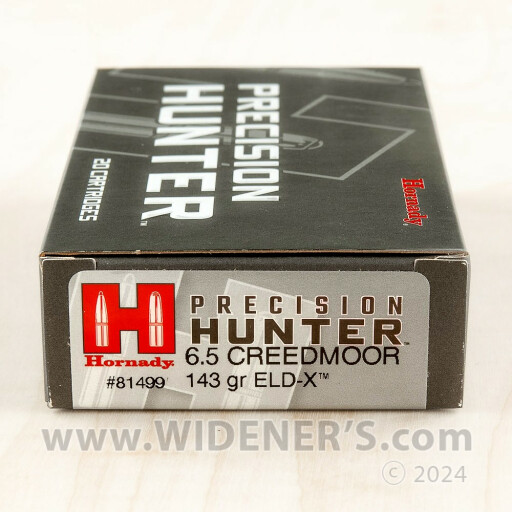
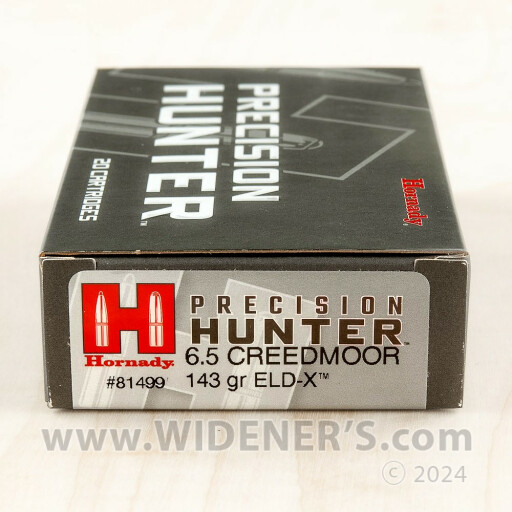
Best 6.5 Creedmoor Ammo: Match-Grade Ammo
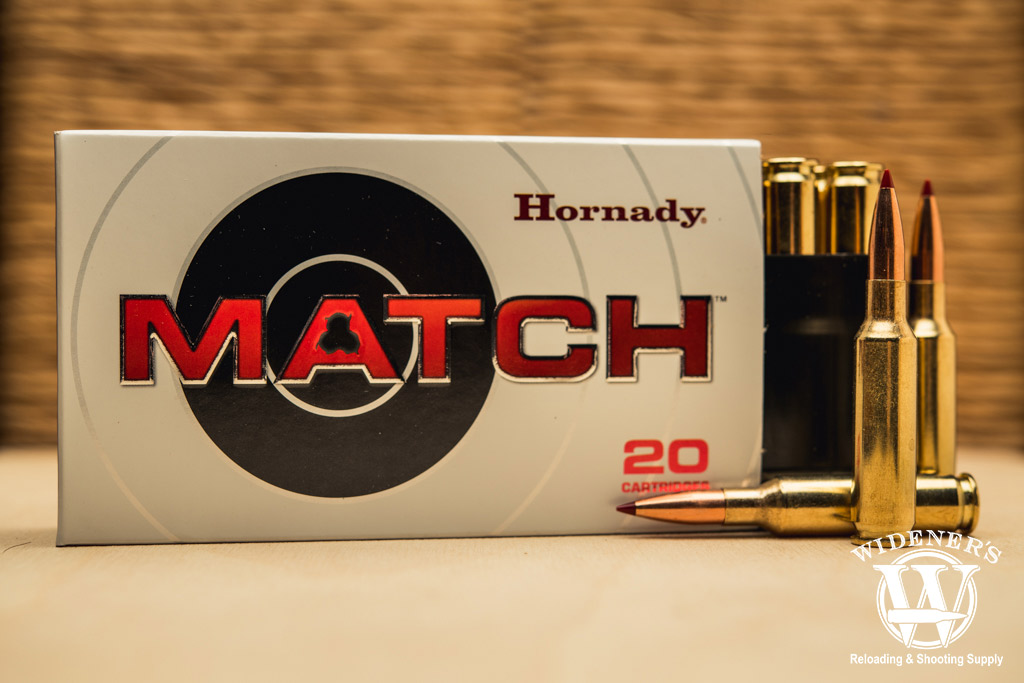
There’s a reason Hornady bullets end up in match-grade ammo; grab a box and you’ll understand.
Hornady 120-grain ELD Match
Muzzle velocity with this 120-grain ELD (Extremely Low Drag) cartridge is a scalding 2,910 fps. Energy comes in at 2,256 ft-lbs. At 100 yards the figures reduce to 2,721 and 1,972, respectively. The bullet is one of Hornady’s latest, first appearing in 2017, and features the company’s polymer Heat Shield tip.
| Caliber | Bullet Type | Bullet Weight | Velocity (Muzzle) | Energy (Muzzle) | 100 Yards (Velocity/Energy) | 200 Yards (Velocity/Energy) | 300 Yards (Velocity/Energy) |
|---|---|---|---|---|---|---|---|
| 6.5 Creedmoor | Poly | 120gr | 2,910 FPS | 2,256 FT LBS | 2,719 FPS/1,969 FT LBS | 2,535 FPS/1,713 FT LBS | 2,359 FPS/1,483 FT LBS |
Winchester Match 140-grain BTHP
The BTHP owns the crown for most long-distance match wins, and likely many more are to come in 6.5 Creedmoor. Winchester harnesses that history with its accurate 140-grain load that leaves the muzzle at 2,710 fps. The bullet carries 2,283 ft-lbs. of energy there. At 100 yards the numbers are 2,556 and 2,030.
| Caliber | Bullet Type | Bullet Weight | Velocity (Muzzle) | Energy (Muzzle) | 100 Yards (Velocity/Energy) | 200 Yards (Velocity/Energy) | 300 Yards (Velocity/Energy) |
|---|---|---|---|---|---|---|---|
| 6.5 Creedmoor | Poly | 140gr | 2,710 FPS | 2,283 FT LBS | 2,556 FPS/2,030 FT LBS | 2,407 FPS/1,800 FT LBS | 2,263 FPS/1,591 FT LBS |

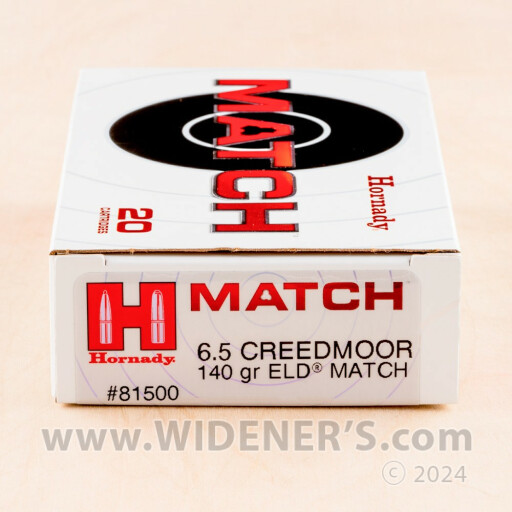
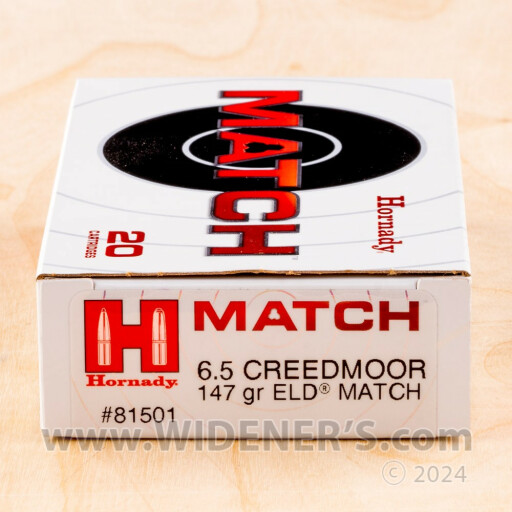
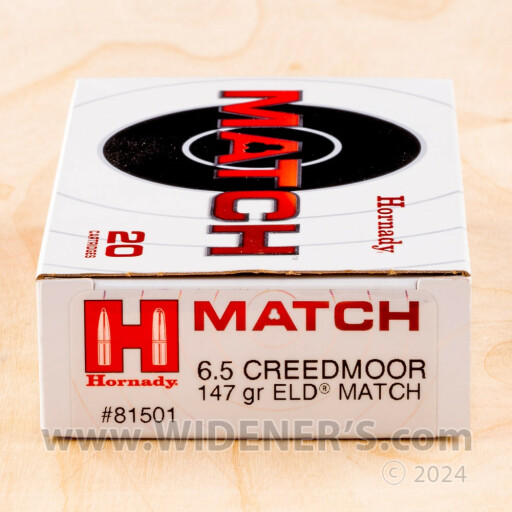
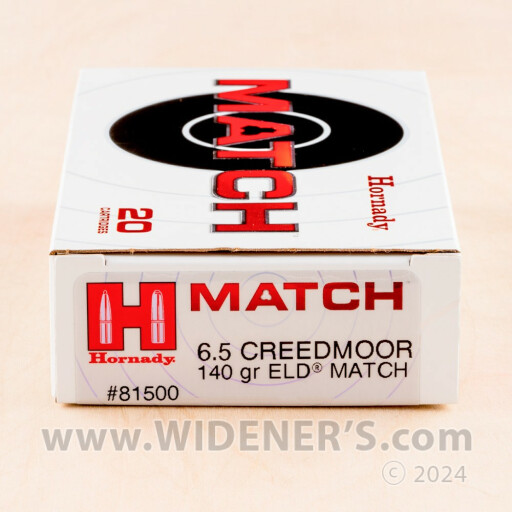
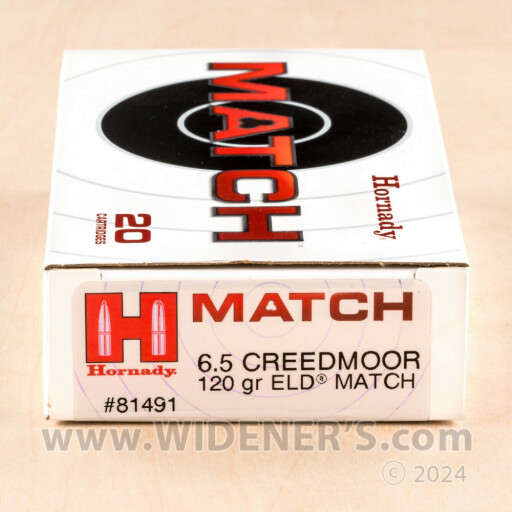
Best 6.5 Creedmoor Ammo: Plinking & Training
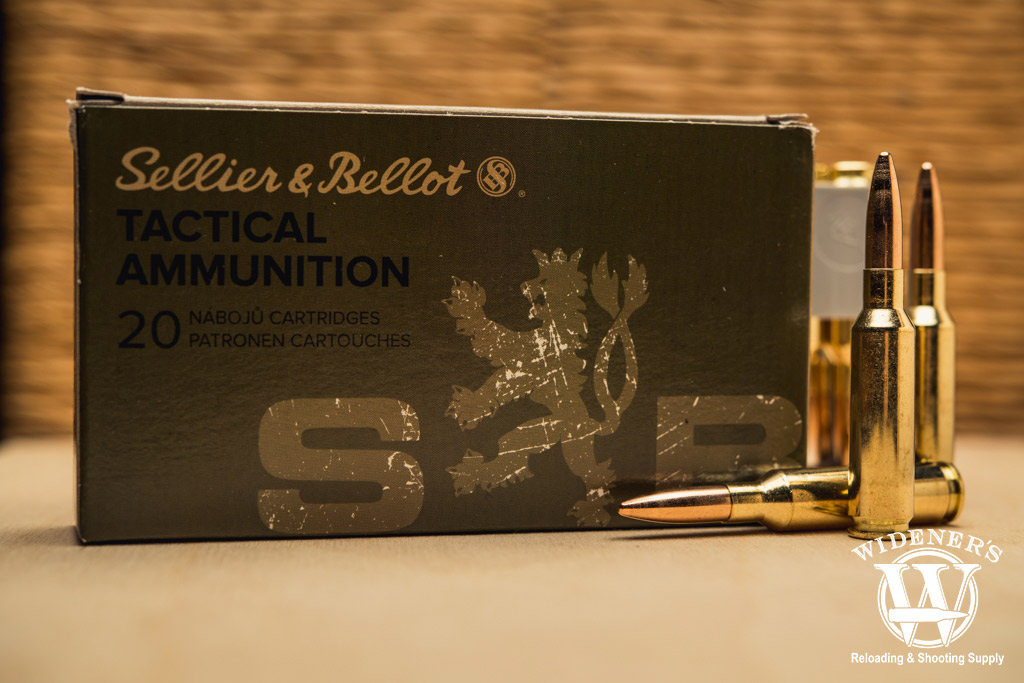
Looking for a great option to sight in an optic? Sellier & Bellot’s 6.5 Creedmoor 140gr FMJ is a great choice.
Sellier & Bellot 140-grain FMJ
If you’re looking for reliable and accurate ammo for plinking or high-volume shooting—without breaking the bank—Sellier & Bellot has the answer in its 140-grain FMJ load. You save more money with the 500-round bulk pack. Muzzle velocity is 2,658 fps and energy 2,195 ft-lbs. At 100 yards the figures, respectively, are 2,444 and 1,856. It’s easily the best 6.5 Creedmoor ammo for plinking.
| Caliber | Bullet Type | Bullet Weight | Velocity (Muzzle) | Energy (Muzzle) | 100 Yards (Velocity/Energy) | 200 Yards (Velocity/Energy) | 300 Yards (Velocity/Energy) |
|---|---|---|---|---|---|---|---|
| 6.5 Creedmoor | FMJ | 140gr | 2,658 FPS | 2,195 FT LBS | 2,444 FPS/1,856 FT LBS | 2,240 FPS/1,559 FT LBS | 2,046 FPS/1,301 FT LBS |
Federal American Eagle 120-grain OTM
For tighter groups downrange, consider American Eagle’s 120-grain OTM (Open Tip Match) load. It’s a great round to dial in an optic or see where your rifle is hitting on paper. Muzzle velocity is 2,900 fps and energy generated there is 2,241 ft-lbs. At 100 yards the corresponding numbers change to 2,680 and 1913.
| Caliber | Bullet Type | Bullet Weight | Velocity (Muzzle) | Energy (Muzzle) | 100 Yards (Velocity/Energy) | 200 Yards (Velocity/Energy) | 300 Yards (Velocity/Energy) |
|---|---|---|---|---|---|---|---|
| 6.5 Creedmoor | OTM | 120gr | 2,900 FPS | 2,241 FT LBS | 2,680 FPS/1,913 FT LBS | 2,470 FPS/1,626 FT LBS | 2,270 FPS/1,373 FT LBS |
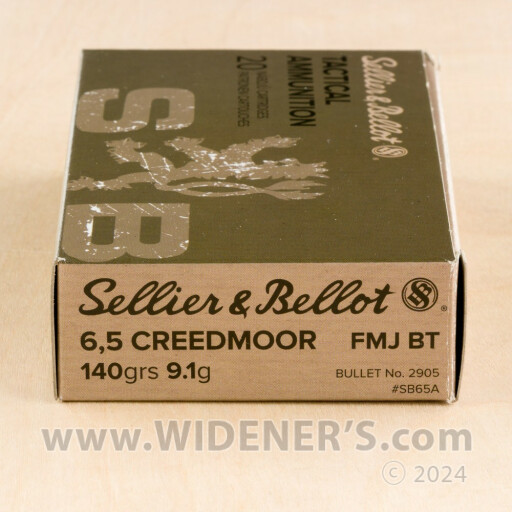
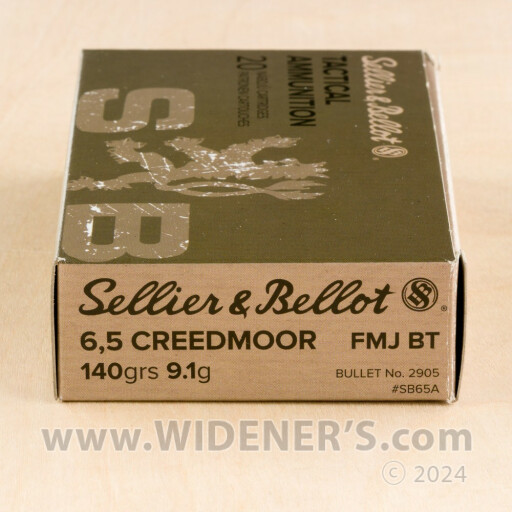
Cartridge Specs & Overview
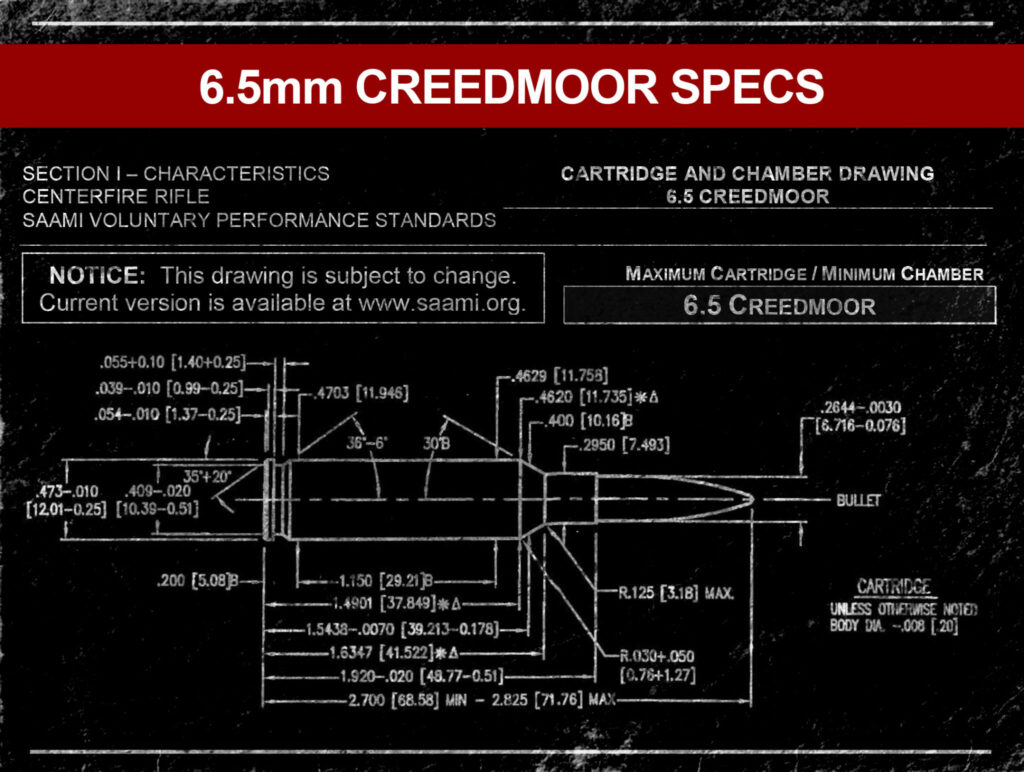
The 6.5 Creedmoor design is an example of excellent balance for size, weight, and propellant.
The 6.5 Creedmoor is a rimless, bottlenecked centerfire cartridge. It comes from a modified .30 Thompson Center case, necked down to accept a .264-inch (6.7mm) diameter bullet. The cartridge case is 1.920 inches (48.8mm) long, with an overall length of 2.825 inches (71.8mm). The 6.5 Creedmoor was designed with the target shooter in mind. It’s sensible ratio of case volume contributes to the cartridge’s high muzzle velocity and energy.
The 6.5mm Creedmoor is offered in a range of bullet weights available in commercial loads. Make no mistake, it’s a precision rifle round. It’s intended purpose is accurately hitting targets at a variety of distances—with bullet weights from 95 grain to 147.
| Cartridge Specs | 6.5 Creedmoor |
|---|---|
| Parent Casing | .30 Thompson Center |
| Bullet Diameter | .264″ |
| Neck Diameter | .295″ |
| Base Diameter | .470″ |
| Case Length | 1.920″ |
| Overall Length | 2.825″ |
| Grain Weight | 120gr-140gr |
| Max Pressure (SAMMI) | 62,000 PSI |
Popular Bullet Types
Full Metal Jacket (FMJ)
Cartridges with FMJ bullets are an accurate option in any chambering and usually the least-expensive option. Those for 6.5 Creedmoor usually weigh 140-grains. The U.S. military cited the cartridge’s versatility for good reason, though, so don’t be surprised to find a lot of changes here (and in other sections) by the time you read this.
Boat Tail Hollow Point (BTHP)
BTHP bullets have a history of winning long-distance competition. The streamlining on the projectile’s backside maintains the kind of ballistic coefficient that prints small groups downrange. Some manufacturers refer to their versions as OTM, or open-tip match. Weights current vary between 120 and 140 grains.
Soft Point (SP)
When it comes to hunting, where ethics dictate expansion and weight retention for big game, soft-point bullets are proven performers. There’s no shortage of weights in this Creedmoor chambering, from 129 to 140 grains.
Polymer Tipped
The space-age polymers on the tips of today’s bullets can ensure fight-stopping terminal performance in self-defense ammo, streamline ballistics downrange, resist heat, hunt with deadly effectiveness, and more. They look good on the bench, too. In 6.5 Creedmoor bullet weight options run from a 90-grain basement to a ceiling of 142. There’s something for taking varmints, predators, elk or feeding that precision rifle when working at 1,000 yards or beyond.
6.5 Creedmoor History
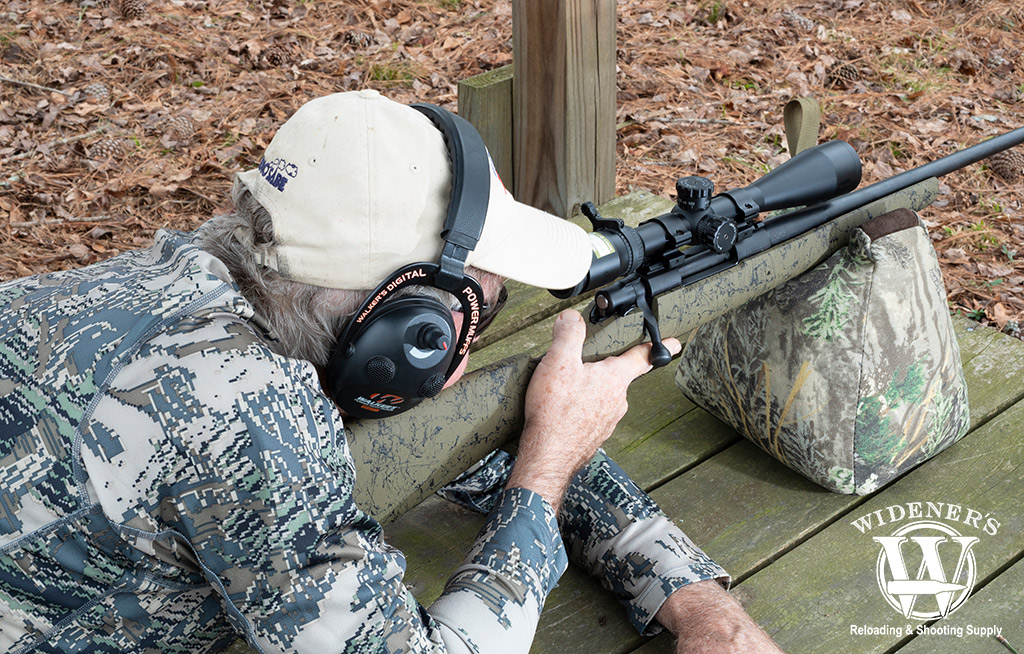
Based on performance and testing, the 6.5 Creedmoor cartridge is the military’s new centerfire selection.
Hornady introduced the rimless, bottleneck cartridge in late 2007 and when commercial loads reached enthusiasts in 2008 reviews were glowing. A critical part of the formula for success is in the 6.5 mm-diameter projectiles, which have a long history of accuracy-enhancing concentricity and improved ballistic coefficients.
Another key ingredient is the case. The 6.5 Creedmoor’s version is based on that of the .30 T/C cartridge—another Hornady innovation introduced at about the same time. The Creedmoor, however, is slimmer at the neck (necked down) to accommodate the smaller-diameter bullet and has a shoulder angle of 30 degrees. Case length is identical, but the powder-carrying portion of it retains the same generous T/C width. Cases with a wider diameter, on average, promote more efficient burning of powder.
The cartridge chambers in short actions, yet another endearing quality for enthusiasts. The Sporting Arms and Ammunition Manufacturers’ Institute (SAAMI) has published standards for 6.5 Creedmoor, and today, there’s no scarcity of rifles in the chambering. Most owners are already well acquainted with the performance and there are a wide variety of application-specific bullets and weights available. Here’s a quick look for those who are not familiar:
Range Report: Best 6.5 Creedmoor Ammo?
There are good reasons the 6.5 Creedmoor has become so popular, so fast. The cartridge was born in 2007 and it didn’t take long for manufacturers to produce cutting-edge and accurate rifles for the chambering. Now that ammunition companies have fine-tuned their respective loads, this soft-shooting “teen” shrinks groups better than ever and is likely on its way to joining some of the greatest in firearm history.


